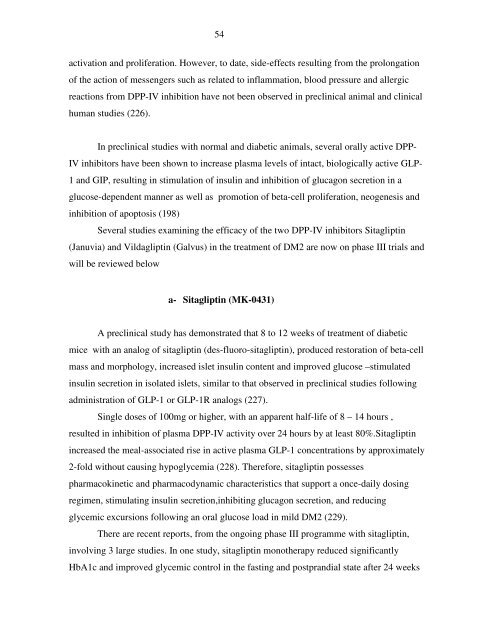1 BETA-CELL FAILURE IN DIABETES AND PRESERVATION BY ...
1 BETA-CELL FAILURE IN DIABETES AND PRESERVATION BY ...
1 BETA-CELL FAILURE IN DIABETES AND PRESERVATION BY ...
Create successful ePaper yourself
Turn your PDF publications into a flip-book with our unique Google optimized e-Paper software.
54<br />
activation and proliferation. However, to date, side-effects resulting from the prolongation<br />
of the action of messengers such as related to inflammation, blood pressure and allergic<br />
reactions from DPP-IV inhibition have not been observed in preclinical animal and clinical<br />
human studies (226).<br />
In preclinical studies with normal and diabetic animals, several orally active DPP-<br />
IV inhibitors have been shown to increase plasma levels of intact, biologically active GLP-<br />
1 and GIP, resulting in stimulation of insulin and inhibition of glucagon secretion in a<br />
glucose-dependent manner as well as promotion of beta-cell proliferation, neogenesis and<br />
inhibition of apoptosis (198)<br />
Several studies examining the efficacy of the two DPP-IV inhibitors Sitagliptin<br />
(Januvia) and Vildagliptin (Galvus) in the treatment of DM2 are now on phase III trials and<br />
will be reviewed below<br />
a- Sitagliptin (MK-0431)<br />
A preclinical study has demonstrated that 8 to 12 weeks of treatment of diabetic<br />
mice with an analog of sitagliptin (des-fluoro-sitagliptin), produced restoration of beta-cell<br />
mass and morphology, increased islet insulin content and improved glucose –stimulated<br />
insulin secretion in isolated islets, similar to that observed in preclinical studies following<br />
administration of GLP-1 or GLP-1R analogs (227).<br />
Single doses of 100mg or higher, with an apparent half-life of 8 – 14 hours ,<br />
resulted in inhibition of plasma DPP-IV activity over 24 hours by at least 80%.Sitagliptin<br />
increased the meal-associated rise in active plasma GLP-1 concentrations by approximately<br />
2-fold without causing hypoglycemia (228). Therefore, sitagliptin possesses<br />
pharmacokinetic and pharmacodynamic characteristics that support a once-daily dosing<br />
regimen, stimulating insulin secretion,inhibiting glucagon secretion, and reducing<br />
glycemic excursions following an oral glucose load in mild DM2 (229).<br />
There are recent reports, from the ongoing phase III programme with sitagliptin,<br />
involving 3 large studies. In one study, sitagliptin monotherapy reduced significantly<br />
HbA1c and improved glycemic control in the fasting and postprandial state after 24 weeks











